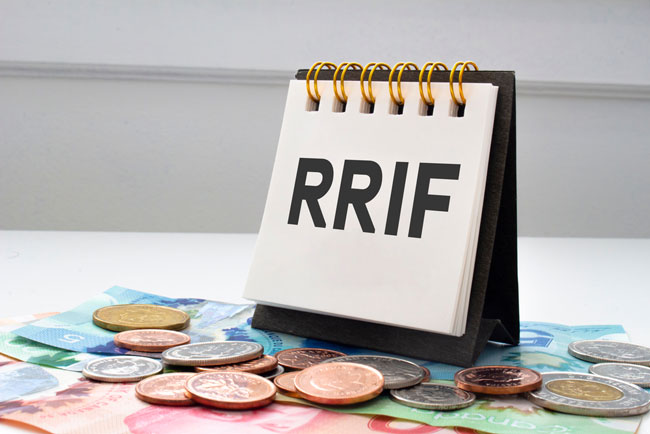Strategies To Reduce Your RRIF Taxable Payments

Get the most benefits from your RRIF
As your active working years come to an end, you need to take steps and make important choices to get the most benefits from your RRIF (Registered Retirement Income Fund). The RRIF is an extension of the Registered Retirement Savings Plan (RRSP), which allows you to get income to cover your basic needs after retirement.
Your contributions to the RRSP are not taxed until you make a withdrawal. The withdrawals are fully taxed. To get the most out of your retirement’s savings, you should first convert your RRSP to RRIF before you reach 70 years. After this, you can take advantage of tax cushions through various ways.
A good RRIF strategy will help you with the following:
1. Get regular income after retirement
Below are some tips to get the most benefits from your RRIF:
- Combine your RRIF with your life annuity which will cover the cost of basic needs for the rest of your life.
- Withdraw RRIF only when necessary and for meeting your living expenses. As your RRIF funds increase, you will enjoy additional tax benefits and your can withdraw more funds.
- You can use any part of your RRIF to purchase annuity at any time. This will give you the security of a guaranteed income stream through the annuity.
- If your spouse is younger than you, use his or her age to calculate the minimum withdrawal amount prescribed by the law. This will help to keep your RRIF higher.
- If your main source of income is RRIF, you should make withdrawals every month. The amount of the withdrawals should be based on other amounts you may be receiving such as pension plans.
- If you want to your capital to grow tax-free, restrict your withdrawals to annually.
- If you are under 71 years, your RRSP can be converted to an RRIF. However, you must withdraw the minimum required amount for that year before conversion can be done.
2. Avoid Tax Traps
You will be eligible to make your first RRIF withdrawal one year after you established the plan. For example, if your RRSP was converted to an RRIF on July 1, you will be eligible for your first withdrawal up to June 30 of the next year.
The minimum withdrawal amount prescribed by law is not taxed. Therefore, consider putting the money for tax purposes. You can enjoy further tax advantages by designating your spouse, children or grandchildren as the beneficiaries of your RRIF.
The capital growth of RRIFs and RRSPs is not taxed. Therefore, you should make withdrawals from other investments other than these retirement plans. The incomes from non-registered investments increase your annual taxable income.
Strategies to Reduce Your RRIF Taxes
You can split your income for certain types of pension incomes to reduce your taxes. For persons over 65 years, incomes that can be split for tax advantages include:
- Income resulting from a non-prescribed annuity contract
- Income resulting from a prescribed annuity contract
- Annuity payments received under a Differed Profit Sharing Plan (DPSP)
- Annuity payments received under an RRSP
- Payments received under a RRIF or a Life Income Fund (LIF)
- Life annuity payments received under an Registered Pension Plan (RPP)
For persons under the age of 65, pension eligible for tax relief include:
- Life annuity payments received under an RPP
The following amount received as a result of death of the individuals’ common-law partner or spouse:
- Income accrued under a non-prescribed annuity contract
- Income portion of a prescribed annuity contract
- Annuity payments received under a DPSD
- Annuity payments received under an RRSP
- Payments received under an RRIF or an LIF
The following types of income are not eligible for tax splitting:
- Incomes such as rent, dividends, interests, etc
- Lump-sum RRSP withdrawals
- Quebec Pension Plan and Canada Pension Plan benefits
- Guaranteed income supplement (GIS)
- Old Age Security (OAS)
To manage your retirement income, it is advisable to consolidate all your RRSPs into a single RRIF. You should examine your RRIF investments to ensure they are in line with your investment requirements, risk tolerance and personal goals.
You should decide whether to go for RRIFs or annuities based on your personal goals and situation. Some people prefer using both investment vehicles to plan for their retirement. With a life annuity, you are guaranteed to get continuous income that will cover your basic needs until you die. On the other hand, an RRIF offers a more flexible income option.
Decide the percentage of RRSP income that will be used to cover expenses for your basic needs. If you anticipate having to use the whole RRSP income, an annuity will be better for supplying a regular income. On the other hand, you can combine RRIF with annuity for your income investment if you have a certain amount of discretionary income.
What to do now?
- We supply you with the best investments in Canada as our brokers represent all the best financial institutions in Canada. For personal assistance on your RRIF please use our RRIF Form.
